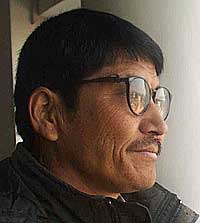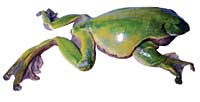 At first glance, it is hard to imagine Kalu Ram Rai getting cosy with cold-blooded frogs and geckos. But this Tribhuvan University lecturer of zoology has spent 17 years teaching and adding to Nepal's herpetofauna by introducing new species of frogs, lizards, and even a turtle. And soon, he is going to realise his life long dream of receiving the first-ever PhD on the subject from TU.
At first glance, it is hard to imagine Kalu Ram Rai getting cosy with cold-blooded frogs and geckos. But this Tribhuvan University lecturer of zoology has spent 17 years teaching and adding to Nepal's herpetofauna by introducing new species of frogs, lizards, and even a turtle. And soon, he is going to realise his life long dream of receiving the first-ever PhD on the subject from TU. For the last two years Rai has spent a lot of time in different parts of east Nepal collecting samples for his dissertation, the impressive sounding "Environmental Impact, Systematics and Distribution of Herpetofauna in East Nepal". For this soft-spoken man with repitilian tastes, it is something of a race against time. "Identifying and recording these species is important, because their natural habitat is being destroyed on such a massive scale, that they might just disappear even before we know they exist," he says.
In the course of his research, Rai recorded three new species of amphibians and two new reptile species-the foot-long Gekko gecko, a rare species of lizard locally known as Tok Tokeh. The earthworm-like Ichthyophis, a limbless amphibian, was also recorded for the first time in Nepal by Rai, along with several others species of frogs, such as the Sphaerotheca rolandae, the Kaloula taprobanica, and even a flying frog-Rhacophorus maximus (see pic). Rai's turtle goes by the zoological name of Cyclemys oldhami.
 Born in Chumlung Village Development Committee of Khotang district, Rai was educated in a simple village school. As a child, he dreamt of becoming a medical doctor, but fate had something slimier in store for him. Rai, who is soon off the Munich University in Germany to do more work on his findings, doesn't mind. He because the more such professionals Nepal has, the better.
Born in Chumlung Village Development Committee of Khotang district, Rai was educated in a simple village school. As a child, he dreamt of becoming a medical doctor, but fate had something slimier in store for him. Rai, who is soon off the Munich University in Germany to do more work on his findings, doesn't mind. He because the more such professionals Nepal has, the better. We profiled another herpetologist, Karan B Shah in October ("Karan's wild side," #57). It turns out Shah and Rai, though competing with each other to become to the first PhD in herpetology from TU, are fast friends, "We share our information whenever we need it, but this time I might end up first, as Shah registered for the PhD later than I did."
Rai's discoveries are not all purely zoological either. Travelling around, he discovered that many communities in the high hills of eastern Nepal eat some species of frogs, like the Man Paha. "People in the hills use it as food because they have limited access to a nutritious diet. It tastes a bit like chicken." A new Nepali export?


